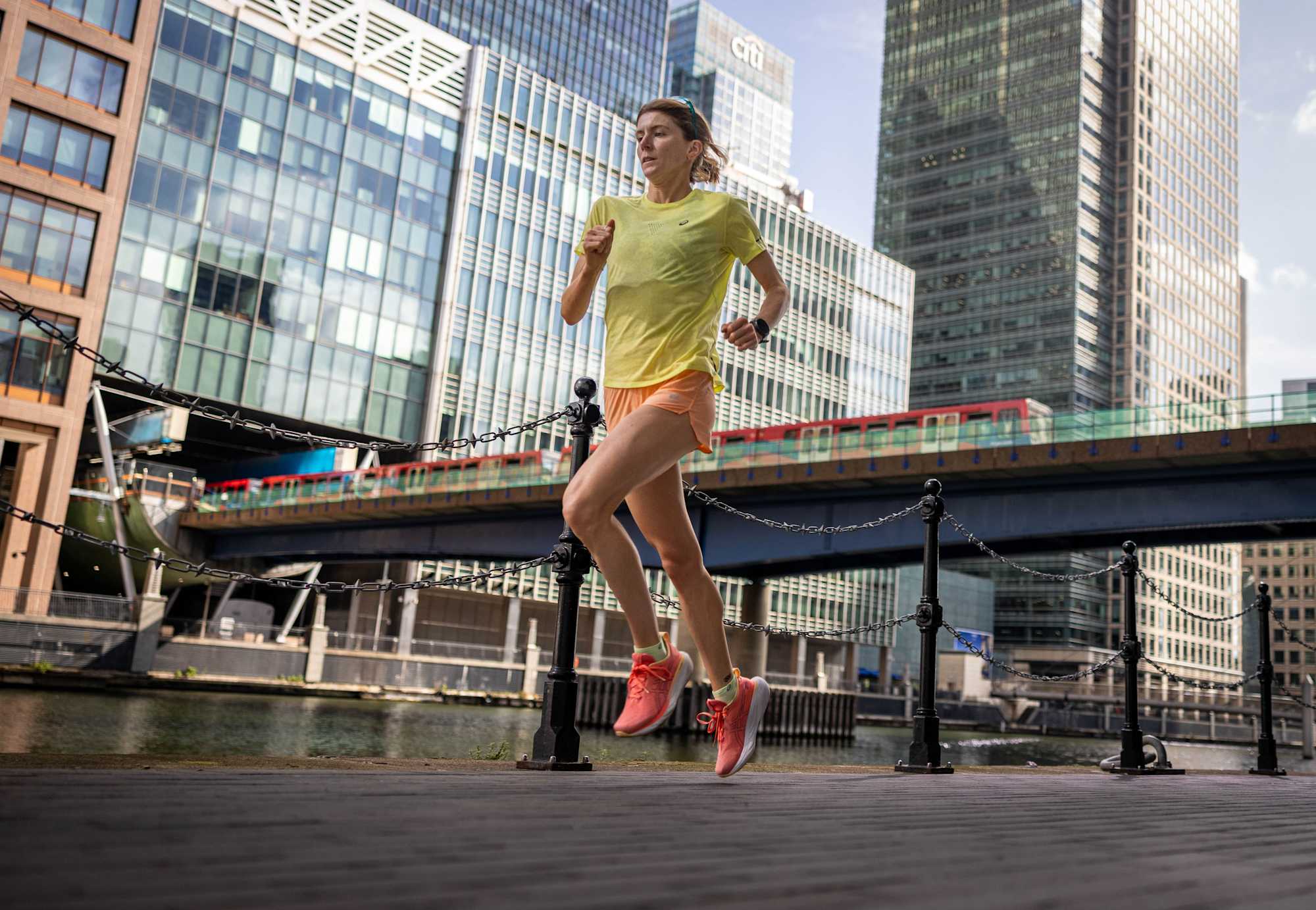Running form: Top tips to improve your pace & technique

Running technique should be as simple as putting one foot in front of the other. We learn to walk, then we learn to run. Simple, right? Watching a youngster running barefoot across a beach, we shouldn’t have too many concerns about running form.
But somewhere along the way to adulthood our lifestyle – and footwear choices – get in the way. We lose the art of flowing movement, and our running form suffers. Often we don’t realise this until we turn to running again in later life, or want to run faster. Or, as is so often the way, when injury strikes.
With this in mind, re-educating ourselves on good running technique can be time well spent. Focusing on technique and form can also be particularly important for long distance athletes running hundreds of miles a month, or triathletes who are already fatigued after swimming and biking.
WHAT IS GOOD RUNNING FORM?
There is a lot of discussion about correct running technique, but whether it’s easy on the eye or not, there’s a solid argument to say that the running form that takes you from A to B as fast as possible is the best running form for you.
This underlines a key point about us all being individuals. But, while not losing sight of this, there are some guiding principles we can adhere to that expert generally agree make for good running form.
TOP TECHNIQUE TIPS
Upright posture with slight forward lean from the ankles, not the hips
Each stride landing under your centre of gravity, not in front
A powerful push off from the big toe, with good leg extension
Relaxed arm swings forward and back with limited lateral movement
Focus on a snappy, fast cadence as opposed to laboured overstriding
Eyes focused around 5-8m ahead
Relaxed breathing, in through the nose and out through the mouth
WHY IS GOOD RUNNING FORM IMPORTANT?
Good running form is important because it…
HELPS US RUN FASTER AND MORE EFFICIENTLY
As we look to improve as runners, we want to either run faster over our chosen distance, or run at the same speed but with less effort. A big chunk of this comes down to our fitness level – the fitter we are the easier the effort for any given pace. However, running form is important too. The smoother we can be, with less wasted energy on each stride, the more slowly we will fatigue, and the faster and longer we can go.
REDUCES THE RISK OF INJURY
Injuries in endurance sport are an ever-present challenge and in triathlon the discipline where we’re most likely to pick up an injury is the run. Unlike the swim and the bike, running is completely weight-bearing, and we absorb the force of several times our own body weight on each stride. Correct running form helps prevent injuries and soreness, particularly to susceptible joints such as knees and hips. There are other elements of run training that are key to avoiding injury. Elements such as strength training and a thorough warm up are also key to injury prevention.
RUNNING FORM FOR BEGINNERS
If you’re new to running, don’t become too bogged down in the detail of how you should run. That might sound strange in an article on running form. But your No 1 focus should be to lace up your trainers, put on a few layers and head out of the door.
From here take your running cautiously. If you’ve not run previously, your body will need time to become accustomed to it, so be patient in building up the distance, and don’t be afraid to rest or take walk breaks. All time spent on your feet is valuable to help your conditioning.
Start to build a healthy habit and enjoy your running before you start to consider form. Many runners also find that the more they run, the more their natural form improves anyway.
Once you come to a point where you want to look at run form specifics, consider the following checklist. A great idea is to make a mental note that you can work through it on each run.
Stay relaxed.
A helpful saying is to “relax from the eyebrows down”. Relaxed running sound straightforward, but can be challenging, particularly as fatigue creeps in.
Control your breathing.
Unless you’re running intervals or sustained tempo efforts, most running should be completed at a conversational pace. This typically means being able to ‘nose breath’ as much as possible – and have a conversation with a running buddy. Try to take deep breaths using your diaphragm rather than shallow chest breathing.
Run tall.
An upright running posture can be a challenge, particularly for runners who have tight hips from sitting for long periods. But think about being more upright with a slight forward lean for momentum from the ankles or calves. An imaginary piece of string pulling on the top of your head can be a helpful visualisation technique.
Arm swing
. Having your arms and hands relaxed will help with the necessary upper body rotation you need for running because your arms provide rhythm, balance and power to your stride. Don’t clench your fists, and consider drawing your arms back rather than thrusting them forwards. ‘Swinging/pumping’ your arms can help determine your leg turnover and pace you want to run at. The more energetic the more your pack picks up. Try it.
Quick cadence.
This can be a good cue to prevent overstriding and reduce the risk of injury. Beginner runners might aim for a cadence of 160 foot strikes per minute. As you speed up, as well as your stride length getting longer, your cadence often quickens too.
Think light and fast.
Even if you’re not running at pace, think of each step as being a light tap on the ground and then off again on to the next stride rather than being a weary plod. Another great visualisation tip!
Don’t worry about foot strike.
While you don’t want your feet to land in front of your body, no matter what you read elsewhere, you also shouldn’t get too hung up on a heel, mid-foot or front foot strike. Concentrate on getting the other cues correct and let your foot strike fall naturally.
WHAT ELSE CAN I DO TO IMPROVE MY RUNNING FORM?
Visit a running coach. We all have slightly different physiologies, limb lengths, biomechanics, ranges of movement old, injuries and past training histories. An experienced running coach will often get you on a treadmill and give an objective view of where and how you can improve your running form.
Hill running or strides. Running up hills or doing ‘strides’ – which is similar to sprinting but without the intensity – can help improve your form. Hill running can really help strengthen the posterior chain (glutes/calves) that will make you a stronger runner, without the impact you get from running on the flat.
Running drills. There are several running drills you can do at the start of a session to help get the feel of good running form. Even something as simple as ‘quick feet’ on the spot at the start of a session can help ingrain light, fast form for the run to come.
Check yourself out. What we think we look like and what we actually look like can be far apart. Check out your form in a mirror if you’re on a treadmill or your reflection in passing shop windows if you’re outdoors. But don’t forget to look where you’re going!
Improve range of motion. If you can utilise your full range of motion without restriction, your running will become more efficient. Being able to open up the hips, loosen off the thoracic spine or maintain the right amount of flexibility in the ankles, can help massively. Try yoga, pilates or a simple all-body stretching programme to help.
Warm-up properly. Warming up diligently before each run can help you assess how your body is responding and allow you to warm up the muscle groups and get them firing for the main session of running to follow.
Strength and conditioning. Having strong and healthy glutes and calves are essential for runners to propel themselves forward with each stride – increasing stride length without compromising form. Consider dedicated strength and conditioning exercises for these muscle groups. Single leg calf raises from a step at the end of each run are a great way to retain healthy lower limbs – particularly as we get older.
FAQS:
What is the best running technique?
The best running technique is the technique that takes you from the start to the finish of your run in the most efficient way possible without risking injury. For most people this will be running tall, engaging the glutes, breathing comfortably and consistently, with feet landing under the body’s centre of gravity on each stride.
What is the correct breathing technique when running?
The correct breathing technique depends on the distance you are running. For endurance athletes, breathing should be calm and relaxed, mainly in through the nose and as deep into the belly as is comfortable so the full capacity of the lungs is being utilised as possible. If breathing is rapid, shallow and in the upper chest, try to calm the body – even if this means dropping the pace – until your breathing is controlled and then build back into the pace.
Running techniques for weight loss?
If you’re running for weight loss, the focus should be on consistency, patience and the resilience to persevere. Don’t become too bogged down in technique initially. Every time you step out of the front door, you’ll be on the right track to hitting your goals. Consider walk-run strategies and be prepared to ease off the intensity to avoid any risk of injury. In terms of specific technique, try not to overstride as this is likely to lead to the fastest way of becoming injured.
Drills to improve running technique?
There are lots of drills you can do to improve running technique and they don’t have to be complicated. Here are three.
High knee drives – focus on the foot springing back off the ground rather than lifting the knee
‘Ankling’ – short, quick steps with the toe barely leaving the ground, while the heel hardly touches the ground
Butt kicks –raise your heel towards your butt, recruiting hamstrings and glutes. Walk through to start and then pick up the pace
What is gait analysis and how can that impact running technique?
Gait analysis a way of analysing your running form – often with you running on a treadmill – to see what happens every time your foot hits the ground. Gait analysis can be used by experts to help pick up any weaknesses or asymmetries in your running style that may lead to injuries or areas that you need to strengthen. It is often used by running shoe retailers to determine what type of running shoes might best suit an individual. For example, a stability (or support) shoe might be recommended to a runner that over pronates (the foot rolls in on landing)
Do I need a coach to improve my running technique?
There is no right or wrong answer here. Running technique can improve just through running more, and there are plenty of resources in books, online and podcasts to give you pointers about how you can improve. However, a running coach has their place too. They will look at you objectively and give tailored advice, assessing individual weaknesses and prescribing exercises to help strengthen areas of the body, such as the glutes, that will improve running technique.







